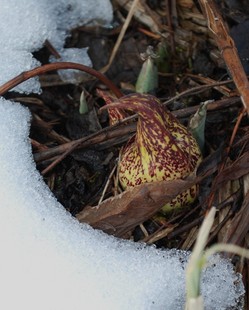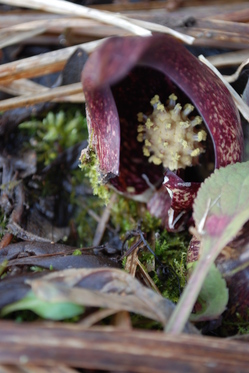Skunk cabbage - native plants' spring leader!

Skunk cabbage (Symplocarpus foetidus) burns through the snow.
Rick Meader|Contributor
Spring, glorious spring! As much as I love snow and slush and bare trees and all the visibility they provide, I love spring much, much more. There are several signs of spring in Ann Arbor to me - the sound of redwing blackbirds, the massive melting of snow, and the opening of the Dairy Queen on West Stadium. But nothing gives an earlier, more reliable sign of spring than the rise and bloom of skunk cabbage (Symplocarpus foetidus).
This amazing little native plant burns its way through the snow with the heat of its own metabolic reactions and, with its pungent odor, attracts the attention of early flies, bees and other insects to its weird little flowers for pollination (its scientific species name “foetidus” gives a clue to the stinky odor that gives it its name) and warmth within its leaves. The odor is particularly noticeable if you break a leaf.
Skunk cabbage grows in wet woods and swamps with persistent moisture. It is not an aquatic plant but likes really wet areas and is in the Arum family, so it is closely related to the jack-in-the-pulpit and green dragon. It’s not tall (approximately 6” tall), and its coloration is somewhat camouflaged, but if you look closely, it is easily found in low areas around Ann Arbor.
The photographs here were taken in the Matthaei Botanical Gardens on Monday, March 1, but I have seen good populations of them in Nichols Arboretum, Hudson Mills Metropark, along Huron River Drive and probably a hundred other wet places around Washtenaw County.

Skunk cabbage flower, safe and warm.
Rick Meader|Contributor
What I haven’t seen before today is the flower. This knobby little beauty takes some effort - and crouching - to find, and you probably don’t want to get your nose too close to it, but it is really neat. Technically speaking, the flower is the plant’s spadix. It is yellow, and is nestled inside the plant’s egg-shaped leaves which unfold into large green leaves after the plant blooms. The fertilized flower yields pea-sized round seeds which are dispersed by animals or water.
In a conversation I had with a naturalist at the Kensington Metropark this weekend, he said that they have found that wild turkeys and deer both eat skunk cabbage flowers. This is surprising, given that the leaf can burn the mouth if eaten, but these animals have both been found to eat them, at least in Kensington. According to the University of Michigan-Dearborn Native American Ethnobotany Web site, Native Americans used it for such things as pain relief, cough relief, epilepsy, female reproductive problems and a variety of other ailments.
So, appreciate the lowly skunk cabbage for its fortitude, and for the knowledge it brings that spring truly is on its way, and enjoy nature, everyone!
Rick is a local landscape architect with a special interest in all things natural, including native plants and the critters that eat them. You can contact him at yourland1824@gmail.com.


Comments
Edward Vielmetti
Sun, Mar 6, 2011 : 2:13 a.m.
Skunk cabbage is out for 2011! Here's a photo from Matthaei: <a href="http://www.flickr.com/photos/i_am_jacques_strappe/5492086811/in/set-98582/" rel='nofollow'>http://www.flickr.com/photos/i_am_jacques_strappe/5492086811/in/set-98582/</a>
Rick Meader
Tue, Mar 2, 2010 : 10:47 p.m.
Thanks to both of you for your comments. Rork, you're right. I found a great article on the web that talks in detail about skunk cabbage, and it confirms what you said. Here is the website: http://www.natureinstitute.org/pub/ic/ic4/skunkcabbage.htm Rick
Rork Kuick
Tue, Mar 2, 2010 : 1:41 p.m.
Small detail: I don't think the purple leaf-like hood (spathe) over the spadix expands into a normal leaf. The normal leaves come later from their own stems, and are a bit like those on Hostas. The heat-making trick is interesting.